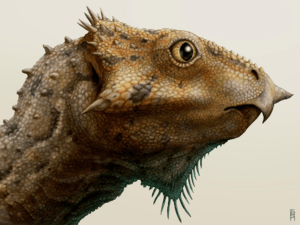Aquilops facts for kids
Quick facts for kids AquilopsTemporal range: Lower Cretaceous
109–104 mya |
|
|---|---|
 |
|
| Restored skull | |
| Scientific classification | |
| Kingdom: | |
| Class: | |
| Superorder: | |
| Order: | |
| Infraorder: | |
| Genus: |
†Aquilops
|
Aquilops was a small dinosaur that lived a very long time ago. It was a type of dinosaur called a Ceratopsian, which means "horn-faced." However, Aquilops didn't have big horns like some of its later relatives.
Scientists found its fossil in Montana, U.S.A.. This dinosaur lived during the Lower Cretaceous period, about 109 to 104 million years ago. That's a really long time! The only part of Aquilops ever found is its skull. It's quite small, even smaller than a grown-up's hand. This discovery was exciting because it was found 20 million years earlier than any other known Ceratopsian in North America.
Contents
What Did Aquilops Look Like?
The skull of Aquilops that was found is about 8.4 centimeters (3.3 inches) long. Scientists think this skull might have belonged to a young Aquilops, not a fully grown one. They believe it was only about 60% of its adult size.
How Big Was Aquilops?
Based on the skull, scientists like Matt Wedel have estimated the full body size of Aquilops. They think it was about 60 centimeters (2 feet) long. That's about the size of a small dog! It probably weighed around 1.5 kilograms (3.3 pounds).
Unique Features of Its Skull
Scientists noticed some special things about the Aquilops skull:
- The bone at the front of its snout, which formed its beak, curved downwards.
- It had a small bump on the front of its snout.
- The upper jaw had a curved shape when seen from the side.
- There was an opening in the skull in front of the eye socket. This opening was twice as long as it was tall and had a pointed back end.
Images for kids
See also
 In Spanish: Aquilops americanus para niños
In Spanish: Aquilops americanus para niños




